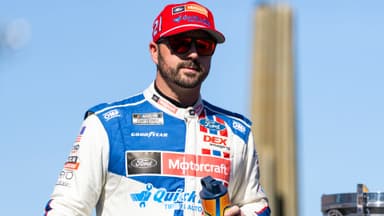NASCAR frequently grapples with the risks of accidents but the specific danger of cars becoming airborne has prompted significant safety actions. Ahead of the Talladega race, the organization has implemented a few modifications to reduce the likelihood of cars flipping on the superspeedway.
Advertisement
Previously, NASCAR had modified akin to a shark fin, extending the length of the car’s greenhouse on the right side, a change first seen before the Coke Zero Sugar 400 at Daytona International Speedway. However, abandoning that change, NASCAR has now added several new features, including an extended-height roof rail designed to obstruct more air when the roof flaps deploy. Thus enhancing the car’s stability during potentially life-threatening situations.
The second involves the installation of fabric beneath the right-side roof flap, integrating a 2-inch fin made of polycarbonate designed to help the roof flap deflect air effectively if the car slides sideways. Additionally, an extended rocker panel skirt along the base of the car will also be installed. The setup will be enhanced by a fabric modification at the inboard edge of the flap, which functions similarly to a parachute, helping to stabilize the vehicle.
The rocker box located beneath the center of the vehicle will be equipped with an aluminum extension. The modification is expected to close the gap between the car’s floor and the ground, further aiding in aerodynamic stability.
While NASCAR’s goal with these changes is to decrease both the likelihood and severity of cars becoming airborne, some fans have expressed dissatisfaction with the modifications, viewing them as overly intrusive or unnecessary.
According to a fan fixing the Next Gen car is more important than such minor changes, who opined, “Fix the Damn car, putting a stupid flap on the windshield isn’t gonna change jack shit.”
One fan calling the changes useless stated, “Great another @NASCAR useless idea.” A fan predicted, “Someone will end up in the stands on Sunday.” Another fan who saw the changes of absolutely no use, said, “Got excited for a moment thinking it was going to be meaningful. Nope, cars are still going to get airborne.”
NEWS: NASCAR to implement aerodynamic changes to vehicles ahead of this weekend's #NASCARPlayoffs race at @TALLADEGA.
— NASCAR (@NASCAR) October 1, 2024
NASCAR’s decision to modify the Next Gen cars was influenced by several alarming wrecks
Though the last major incident involving a car becoming airborne at Talladega occurred in 2019 when Brendan Gaughan’s No. 62 went airborne, flipped, and landed on its tires, subsequent accidents have further pressed the issue. Notably, Ryan Preece’s harrowing crash last year, where his car flipped multiple times at Daytona International Speedway in August, served as a wake-up call for NASCAR.
This year added to the concerns, with Corey LaJoie‘s unexpected flip at Michigan in August marking the first blow-over crash at a non-superspeedway track in the Cup Series since 2010.
In response, NASCAR implemented an air deflector ahead of the Daytona race to help prevent such incidents. Unfortunately, the measure proved insufficient as evidenced by Michael McDowell‘s near flip in front of the pack and Josh Berry’s accident. Berry’s #4 car, after spinning to the inside of the track, lifted off the ground, flipped onto its roof, and slid into the inside wall, spinning like a top while remaining inverted.







